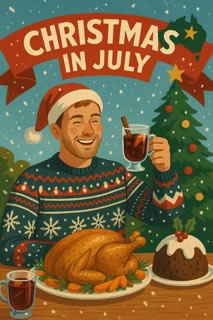 For many Australians, December 25 means prawns on the barbecue, backyard cricket, and sweating through a roast dinner in 30-degree heat. It's festive, sure—but it's a far cry from the snow-dusted scenes plastered across wrapping paper and Christmas movies.
For many Australians, December 25 means prawns on the barbecue, backyard cricket, and sweating through a roast dinner in 30-degree heat. It's festive, sure—but it's a far cry from the snow-dusted scenes plastered across wrapping paper and Christmas movies.
That's where Christmas in July comes in.
While it's not an official holiday, Christmas in July has become a popular excuse for Australians to throw on a jumper, sip mulled wine, and enjoy the kind of wintry Christmas feast our Northern Hemisphere cousins take for granted. It's quirky, a little kitsch, and genuinely beloved in homes, pubs, restaurants, and alpine towns around the country.
Where Did It Come From?
The idea didn't start in Australia. Christmas in July reportedly began in the 1930s at a girls' summer camp in North Carolina, USA. But Australians embraced it more fully, perhaps because it fills a seasonal and social gap during our long winter months.
It gained traction in the 1980s and '90s, when ski resorts like Thredbo and Mount Buller began hosting festive winter celebrations. With log fires, Christmas trees, and even the odd snowman, the idea of a "proper" Christmas—cold weather and all—really took hold.
Since then, it's become a widespread tradition.
Why Celebrate It?
Put simply: it's fun. And it makes sense.
July is the coldest month in Australia. While our official Christmas falls in summer, many people have strong cultural ties to wintry traditions, thanks to British and European heritage, or just a deep love of snowy holiday films and carols about sleigh bells.
Christmas in July offers a chance to lean into that atmosphere: roast turkey, hot pudding, mulled wine, woolly jumpers, and fake snow. For some, it's a nostalgic novelty. For others, it's just a good excuse to gather friends for a mid-year party.
Restaurants and pubs often join in, offering themed dinners and specials. Families host mock-Christmas dinners, complete with crackers and bad jokes. Even workplaces sometimes run Secret Santa gift swaps for a bit of winter cheer.
It's Not About Replacing the Real Thing
Christmas in July isn't trying to replace December 25. Most people still celebrate the real thing with the usual Aussie summer traditions. But having a second, mid-year celebration feels like a bonus—a way to break up the cold season and do Christmas differently.
In the end, Christmas in July is exactly what you want it to be: a warm gathering in the middle of winter, a themed night out, or simply a reason to indulge in pudding without needing sunscreen.
And for a country that straddles both European tradition and Southern Hemisphere seasons, it might just be the most Australian Christmas of all.
